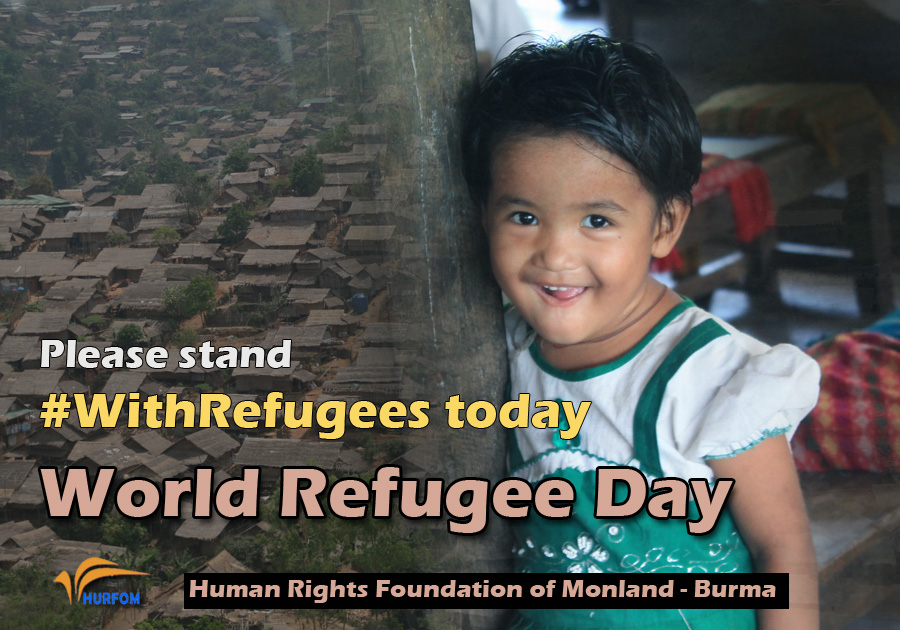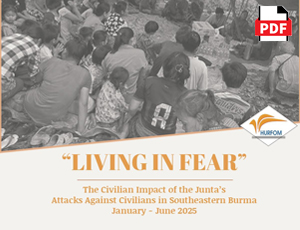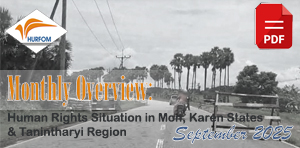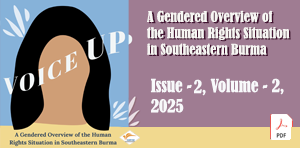HURFOM: World Refugee Day Statement
June 20, 2017
 Today the Human Rights Foundation of Monland (HURFOM) commemorates World Refugee Day and the estimated 65 million asylum-seekers and Internally Displaced Persons (IDPs) around the world. Despite ongoing political and economic transformations in Burma/Myanmar which saw the election of the National League for Democracy (NLD) in the country’s first free and fair elections in 25 years, the number of displaced persons have continued to climb. With the violence in northern Rakhine State and the ongoing armed conflict in northern Kachin and Shan states, recent estimates put the total number of Burma/Myanmar refugees and IDPs at over 1.1 million.
Today the Human Rights Foundation of Monland (HURFOM) commemorates World Refugee Day and the estimated 65 million asylum-seekers and Internally Displaced Persons (IDPs) around the world. Despite ongoing political and economic transformations in Burma/Myanmar which saw the election of the National League for Democracy (NLD) in the country’s first free and fair elections in 25 years, the number of displaced persons have continued to climb. With the violence in northern Rakhine State and the ongoing armed conflict in northern Kachin and Shan states, recent estimates put the total number of Burma/Myanmar refugees and IDPs at over 1.1 million.
HURFOM stands in solidarity with the displaced persons of Burma/Myanmar and wishes to highlight the protracted displacement of individuals and families along the Thai-Burma/Myanmar border. After almost 70 years of conflict there are still over 100,000 refugees in nine camps in Thailand and approximately 400,000 IDPs throughout southeast Burma/Myanmar. The political and economic changes in Burma/Myanmar has led many donors and aid organizations to reprioritize their funding streams away from the border area in the erroneous belief that with the changes taking place, the voluntary and dignified return of refugees and IDPs will shortly follow.
In August 2016, HURFOM published ‘Invisible Lives: The Untold Story of Displacement Cycle in Burma’ with Burma Link and Progressive Voice. In this report on Mon IDPs and refugees, many interviewees expressed their desire to stay in their current location and voiced their opposition to return.
The lack of sustainable peace, as well as the continuing occurrences of armed skirmishes between government forces and Ethnic Armed Organizations (EAO), as well as between EAOs, leave many Mon refugees and IDPs wary of returning.
“We worry that the ceasefire will break. If the ceasefire agreement breaks, we are worried that the Burmese troops will come here and cause problems for us.”
Nai T—, Mon IDP, Male, Jo Haprao
“I am still afraid of Burmese soldiers throughout my life because of what I have faced. Because we have stayed here for ages, they would suspect that we all are Mon soldiers if I go back. Even If I go for a visit, they will question me and put me on the list. Then they will create problems for our relatives who live in the village when the ceasefire is broken. I worry for them.”
Mi L—, Mon IDP, Female, Halockhani, (cousin was killed due to suspected connection to the Mon National Liberation Army)
Another major factor cited for preferring to stay in their current locations is the absence of land, property, and housing (LPH) rights needed in order to create sustainable livelihoods. Land confiscations in their former villages leave many refugees and IDPs skeptical about the ability to support themselves upon their return.
“Some people want to go back to their origin, but there are no houses, no place, no properties. So here they have a house. And also here is the NMSP [New Mon State Party]-controlled area, so they live in peace…That’s why they live here. They still want to go back, but there is no place, there are no houses, no farms.”
Nai B—, Mon IDP, Male, Jo Haprao
Military impunity for past and current human rights violations, land confiscations, landmines, and the absence of inclusive ceasefires and ongoing conflict in the northern and western parts of Burma/Myanmar are all barriers to legitimate, dignified, and voluntary return of refugees and IDPs.
Housing, property, and land rights must be acknowledged and restored, and landmines must be removed before meaningful discussions of dignified and voluntary return can occur. The current peace process must include meaningful provisions for the return and restitution of rights for refugee and IDP communities.
“It has been over a year since the NLD government took power in the country and the government has set up some refugee repatriation pilot projects, but the results were not very promising. The government should dig down to the root causes of decades old displacement and begin addressing this using United Nations (UN) guidelines, such as the UN Guiding Principles on Internal Displacement and the Pinheiro Principles on Housing and Property Restitution for Refugees and Displaced Persons, in order to ensure those communities are receiving justice.
All steps of any repatriation plans must be dignified, voluntary, and sustainable, and guarantees of non-repetition should be included. During rehabilitation processes, all representatives from the government, EAOs, and other stakeholders must recognize the IDP/refugee issues inclusively and ensure that all levels of decision making on repatriation and rehabilitation plans must be in meaningful consultation with affected individuals and communities.”
Nai Aue Mon, Program Director, HURFOM
Comments
Got something to say?
You must be logged in to post a comment.



















































